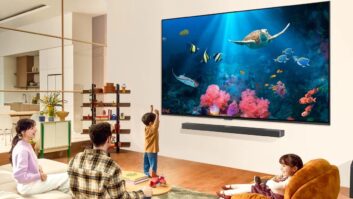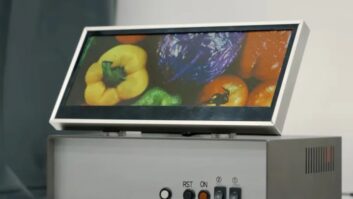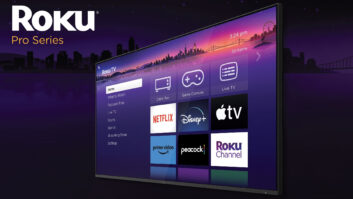TWICE: How did the custom market do in 2005, and what are the prospects for 2006?
Scott Sylvester, Sonance product strategy director: If you look at the 2005 numbers, it is clear that the custom market is really taking hold of the mainstream consumer. Fourteen percent growth is pretty darn healthy. And when you look at what’s happening within each segment — in-ceiling and in-wall designs outselling freestanding speakers for the first time since we introduced the in-wall category in 1984 — you can definitely see that the custom market is an industry on the move. In terms of market share, these two categories now lead the way among floor, shelf and outdoor designs.
Paul Bente, JBL consumer products president: The industry is easily growing at 20 percent-plus year-on-year, and most indicators point to an even more vigorous growth potential if more qualified installers were available. Indeed, many of our customers are turning away business simply because they can’t (and quite correctly, I might add) handle any more.
JBL serves all custom installation segments, and we are absolutely seeing growth in the lower end of the production homes market, with packages for distributed audio, family rooms and home theaters. We are also experiencing growth in our traditional segments of high-end home theater and distributed-audio installations interfaced with control, lighting and environmental software systems.
Mike Detmer, Niles Audio sales and marketing VP: As more homeowners embrace the contemporary audio/video lifestyle, custom installed products continue to grow in popularity. This drove Niles sales to new heights in 2005 and will continue to do so in 2006. Product categories that keep showing phenomenal growth include ceiling-mounted loudspeakers, multizone distributed entertainment systems and remote controllers.
T. Paul Jacobs, Klipsch Audio Technologies president: It was a good year. Housing starts continued to be strong, and interest rates stayed low throughout 2005. Consumers were making sure their homes were fully stocked. From Klipsch’s perspective, the audio side of the business is strong and primarily driven by preconstruction. There are a limited number of audio players in the custom market, so most key suppliers experienced double-digit growth, just like Klipsch has for eight consecutive years.
Now, interest rates are going up, and new housing starts will slow. The housing market has been so strong for so long that many installers have not had enough experience with retrofit, even though $3.5 billion will be spent on home remodels in the next three years. $3.5 billion is significant money, and a good portion of that will be for automation electronics and sound.
For the companies able to transition into a retrofit business, 2006 will be a great year. It is a tougher business, and going into retrofit could be a real challenge, particularly for the professional installers.
Robert Weissburg, D&M North American sales and marketing president: The custom-focused A/V specialist and the independent custom installer drove significant growth during 2005. Existing homes and new construction fueled this expansion along with the popularity of flat-panel televisions, home theater systems and recent popularity of HDTV broadcasts.
Jeff Kussard, Russound strategic development VP: I can say that 2005 is definitely up and looks like it will prove to be another record year of growth. Although financial indicators would have us feeling conservative about 2006, dealer and consumer sentiment appear to be bullish about 2006.
TWICE: What is responsible for growth?
Sylvester: When you see Bill Gates touting the connected home every year at the Consumer Electronics Show, you have to believe that everyone’s sights are on the custom home market.
Growth is coming from several different fronts — the primary one being today’s hot housing market. With housing prices being what they are, people are reinvesting in their homes. Retrofitting is what’s in as homeowners look to modernize the look and features of their older homes. You also see owners of smaller-footage homes looking to maintain floor space, which I think speaks to why in-wall and in-ceiling speakers have really taken hold with consumers.
Then there’s the new-home market. What we’re seeing is production homes offering more audio options at the point of sale.
You also have the growing popularity of flat-panel TVs and home theater systems — which is really fueling what’s going on in the custom-home market. Much of that has to do with dropping prices on these items, as wholesale prices of flat-panel, LCD and plasma TVs are really accelerating installed audio sales.
You’re also seeing the HVAC, security and lighting markets really trying to expand their reach, and the custom home market is a natural progression for them.
Broader price ranges in this category are also expanding the appeal of this market. I mean, when you see the Best Buys and Tweeters of the world offer custom retail installation, you have to believe this market is really hitting the mainstream.
Bente: The fact that consumers — home buyers and home owners — consider home theater and distributed audio as important parts of their new or current dream homes makes all of what we are doing so relevant. And, if the price of a good home theater at retail is $20,000, in a new home purchase or a retrofit to an existing home, in reality it becomes a few more dollars every month added to a mortgage or a home equity loan.
More than ever before, the home is becoming an integrated technology center, and builders and homeowners are looking for whole-house solutions that are part of the home, not an afterthought.
I recently attended a builder’s conference, and many of the seminars were all about technology, home theater and distributed audio. The reason was pure and simple: This is what consumers are looking for.
Detmer: Heightened consumer awareness and positive attitudes toward the pleasing aesthetics and high performance of flat-panel televisions and concealed sound systems are responsible for the custom industry’s sustained growth. Everyone wants a nice home, and custom installed audio/video systems are fast becoming the norm as homeowners see them as a necessity for contemporary living.
Al Baron, Polk Audio custom installation products line manager: Several factors are driving multiroom audio/video [MRAV] growth, but none is more important than the low cost of home financing. Low interest rates have driven housing demand and real estate value. Housing starts were at an all-time high in 2005. Thanks to better builder and consumer awareness of the possibilities and benefits of built-in and multiroom audio and video, those housing starts drove MRAV sales. Rising home values combined with low interest rates fueled home renovations, which in turn drove MRAV sales higher.
We see two other major factors to explain growth: demographics and new video technology. Baby boomers are at peak wealth, transitioning into empty-nest status, largely have college expenses behind them or at least in sight of ending, and they are building or renovating their last home. They want that home to fulfill all their dreams in regards to amenities and technology.
New video technologies such as HD and flat-panel displays are driving consumer interest and, in the custom arena, the attachment rate of audio to video sales is much higher than in retail stores where the attachment rates are disappointing to retailers and audio manufacturers alike.
The Fed is expected to continue to raise interest rates through 2006. Eventually that will have an impact on housing starts, real estate values and consumers’ appetites for continued spending. At some point these factors will slow the growth rate of MRAV sales. Our hope, however, is that increased MRAV awareness by the builder and the consumer, along with the lower cost of technology, will counterbalance these economic issues. This is information that we have yet to divine from our Magic Eight Ball forecasting tool.
Jacobs: The incredible level of new housing starts set the stage for growth in 2005. The other major growth factor was access to the products and their top-of-mind visibility to consumers. Media exposure of home automation, installation and custom-market technologies are at an all-time high. Combine this exposure with the high housing starts, and you get a really explosive market. Also, the aging population with high levels of disposable income, low mortgage rates and the visibility and access to technology were all part of driving the business.
A/V chains may have raised consumer awareness, reaching the middle class, but awareness among architects and interior designers has had a larger impact.
Weissburg: With increased gas prices and ticket prices at the box office, many people are bringing entertainment back into the home by investing in a home theater. In addition, consumers realize that current products in the market, and the concept of integrating A/V into a home, is not a simple proposition, and they are turning to professionals for help.
The concept of HDTV, broadband, satellite, HD-DVD/Blu-ray, 1,080p, HDMI, DVI, distributed audio, media servers and the integration with computer networking are complicated and confusing to most consumers.
It’s obvious that this channel of distribution is expanding and growing faster than the traditional retail channels that built the A/V industry. That creates a major challenge. Certainly product development that supports new technology, connectivity, reliability and ease of installation are very important. Making the commitment to support the channel with technical expertise, training, communication, certification and education are key elements that will differentiate one manufacture from another.
The support needed ranges from purchasing programs to online technical training, which are winning over the installers; anything that makes their job easier and more predicable will build loyalty.
Kussard: In general terms, the growth of this past year is a reflection of the continued upward trend toward maturation of the installed residential systems contracting sector. The main drivers remain pretty much the same as past years — promotion of awareness by dealers and trade groups like CEDIA and the CEA, HomeTech MultiRoom A/V Council among the builder, architect and designer communities, combined with incremental growth in consumer awareness.
It is important to note that we are seeing increased interest among production builders. This interest is just starting to expand beyond structured wire into distributed audio, video and home networking implementation. We at Russound are working with dealers who have built their businesses around the model of serving as residential systems subcontractors to production builders, and to larger regional builder/developers, to promote a higher level of understanding and promotion of multiroom audio video to prospective home owners.













